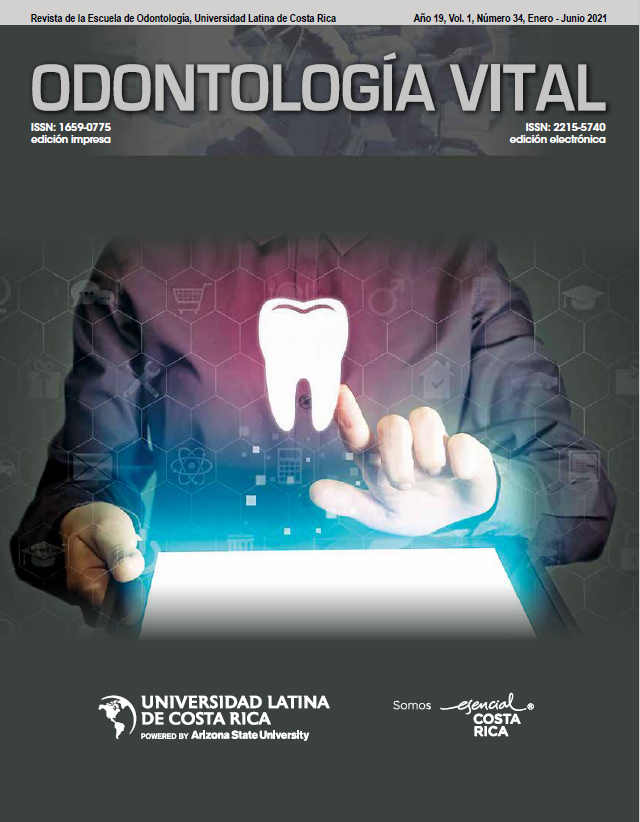Clinical-microbiological vigilance of a C Grade Periodontitis Stage III in five years
DOI:
https://doi.org/10.59334/ROV.v1i34.423Keywords:
Periodontal disease, oral microbiology, periodontal debridement, therapeutics.Abstract
Introduction: There are several techniques to treat and maintain teeth affected by stage III, grade C periodontitis, nonetheless, the scientific evidence available on how periodontal clinical parameters and microbiological composition may be modified during the conventional and surgical treatment is scarce.
Objective: to evaluate the clinical and microbiological response of a patient with stage III grade C, generalized periodontitis, during 5 years, treated with non surgical and surgical periodontal therapy using regenerative material and bone substitute.
Methodology: The patient was treated with scaling and progressive root planning, combined with antibiotics and surgical therapy was performed in sites with infraosseous defects. At each time of treatment, subgingival bacterial plaque (PB), haemorrhage (H), probing depth (PD) and clinical attachment level (CAL) were recorded. To identify periodontal bacteria by molecular biology samples were taken with endodontic cones from the pocket depth.
Results: a significant difference of PB, H, PD was observed. The PD decreased and CAL was gained throughout the treatment. PD decreased 5 mm with the application of bone substitute, and CAL gained 5 mm, with the use of amelogenins the difference of PD and CAL was 4.5 mm. In access flap the PD decreased 3 mm and the CAL improved 2 mm. T. denticola was identified at 36 months in all pockets treated with access flap and in 50% of the pockets with bone graft, and P. gingivalis at 60 months.
Conclusions: The periodontal treatment applied prevented the loss of the affected teeth. Improvement of clinical parameters was associated with a non-aggressive microbiota.
Downloads
References
Artzi Z, Tal H, Platner O, Wasersprung N, Weinberg E, Slutzkey S, et al. Deproteinized bovine bone in association with guided tissue regeneration or enamel matrix derivatives procedures in aggressive periodontitis patients: a 1-year retrospective study. J Clin Periodontol. 2015;42(6):547-56. https://doi.org/10.1111/jcpe.12413
Ashimoto A, Chen C, Bakker I, Slots J. Polymerase chain reaction detection of 8 putative periodontal pathogens in subgingival plaque of gingivitis and advanced periodontitis lesions. Oral Microbiol Immunol. 1996;11(4):266-73. https://doi.org/10.1111/j.1399-302X.1996.tb00180.x
Colombo AP, Bennet S, Cotton SL, Goodson JM, Kent R, Haffajee AD, et al.Impact of Periodontal Therapy on the Subgingival Microbiota of Severe Periodontitis: Comparison between Good Responders and “Refractory” Subjects by the Human Oral Microbe Identification Microarray (HOMIM)J Periodontol.2012;83(10)1279-87. https://doi.org/10.1902/jop.2012.110566
Cortellini P, Buti J, Pini Prato G, Tonetti MS. Periodontal regeneration compared with access flap surgery in human intrabony defects 20-year follow-up of a randomized clinical trial: tooth retention, periodontitis recurrence and costs. J Clin Periodontol. 2017;44(1):58-66. https://doi.org/10.1111/jcpe.12638
Froum S, Cho SC, Rosenberg E, Rohrer M, Tarnow D. Histological comparison of healing extraction sockets implanted with bioactive glass or demineralized freeze-dried boneallograft: a pilot study. J Periodontol. 2002;73(1):94-102. https://doi.org/10.1902/jop.2002.73.1.94
Guarnieri R. Long Term (15 to 20 years) outcomes of Papillae Preservation Flap Surgery in Esthetic Areas. Int J. Periodontics Restorative Dent 2019, 39(3):349-59. https://doi.org/10.11607/prd.4017
Lang NP, Suvan JE, Tonetti, MS. Risk factor assessment tools for the prevention of periodontitis progression a systematic review. J Clin Periodontol 2015;42(Suppl. 16):S59-S70. https://doi.org/10.1111/jcpe.12350
Page, RC, Elke, PE. Case Definitions for Use in Population‐Based Surveillance of Periodontitis Periodontol 2007;78(7Suppl):1387-99. https://doi.org/10.1902/jop.2007.060264
Papapanou PN, Sanz M, Buduneli N, Dietrich T, Feres M, Fine DH, et. Periodontitis: Consensus report of work-group 2 of the 2017World Workshop on the Classification of Periodontal and Peri-Implant Diseases and Condi-tions. J Periodontol.2018;89(Suppl 1):S173-S82. https://doi.org/10.1002/JPER.17-0721
Proussaefs P, Lozada J, Kleinman A, Rohrer MD, McMillan PJ. The use of titanium mesh in conjunction with autogenous bone graft and inorganic bovine bone mineral (bio-oss) for localized alveolar ridge augmentation: a human study. Int J Periodontics Restorative Dent. 2003;23(2):185-95.
Rodrigues AS, Lourenção DS, Lima Neto LG, Pannuti CM, Hirata RD, Hirata MH, et al Clinical and Microbiologic Evaluation, by Real-Time Polymerase Chain Reaction, of Non-Surgical Treatment of Aggressive Periodontitis Associated With Amoxicillin and Metronidazole. J Periodontol. 2012;83(6):744-56. https://doi.org/10.1902/jop.2011.110333
Romito GA, Feres M, Gamonal J, Gomez M, Carvajal P, Pannuti C, et al Periodontal disease and its impact on general health in Latin America: LAOHA Consensus Meeting Report. Braz Oral Res. 2020; 9;34(supp1 1):e027. https://doi.org/10.1590/1807-3107bor-2020.vol34.0027
Rosalem W, Rescala B, Teles RP, Fischer RG, Gustafsson A, Figueredo CM. Effect of non-surgical treatment on chronic and aggressive periodontitis: Clinical, immunologic, and microbiologic findings. J Periodontol.2011;82(7):979-89. https://doi.org/10.1902/jop.2011.100579
Roshna T, Nandakumar K, Generalized Aggressive Periodontitis and Its Treatment Options: Case Reports and Review of the Literature. Case Rep Med. 2012;2012:5353-21. https://doi.org/10.1155/2012/535321
Silva-Senem MX, Heller D, Varela VM, Torres MC, Feres-Filho EJ, Colombo AP. Clinical and microbiological effects of systemic antimicrobials combined to an anti-infective mechanical debridement for the management of aggressive periodontitis: a 12-month randomized controlled trial. J Clin Periodontol. 2013;40(3):242-51. https://doi.org/10.1111/jcpe.12052
Usin MM, Tabares SM, Menso J, Ribotta de Albera E, Sembaj A. Generalized aggressive periodontitis: microbiological composition and clinical parameters in non-surgical therapy. Periodontitis agresiva generalizada: compo-sición microbiológica y parámetros clínicos en la terapia no quirúrgica. Acta Odontol Latinoam. 2016;29(3):255-61
Downloads
Published
License
Copyright (c) 2021 María M. Usin, Sandra Tabares, Adela Sembaj, Estela Ribotta de Albera

This work is licensed under a Creative Commons Attribution 4.0 International License.
Authors who publish with Odontología Vital agree to the following terms:
- Authors retain the copyright and grant Universidad Latina de Costa Rica the right of first publication, with the work simultaneously licensed under a Creative Commons Attribution 4.0 International license (CC BY 4.0) that allows others to share the work with an acknowledgement of the work's authorship and initial publication in this journal.
- Authors are able to enter into separate, additional contractual arrangements for the non-exclusive distribution of the Odontología Vital's published version of the work (e.g., post it to an institutional repository or publish it in a book), with an acknowledgement of its initial publication.
- Authors are permitted and encouraged to post their work online (e.g., in institutional repositories or on their website) prior to and during the submission process, as it can lead to productive exchanges, as well as earlier and greater citation of published work.







